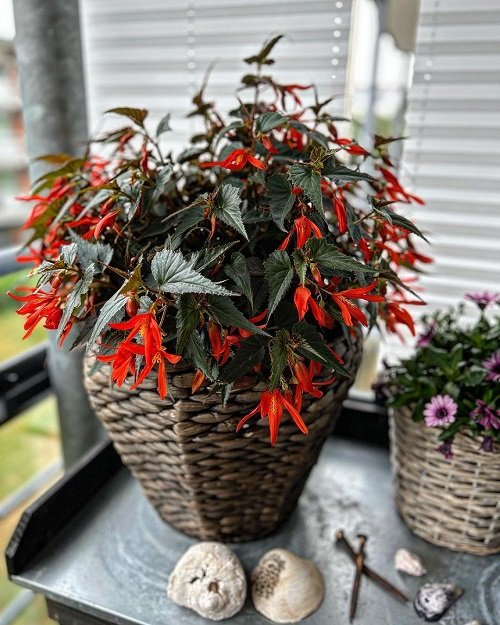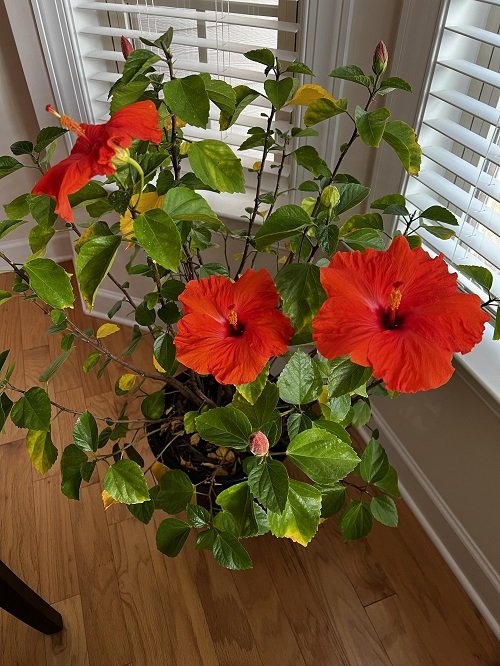Look here at twelve Indoor Plants That Bloom According to 12 Months and enjoy a year-round display of floral beauty.
These blooming specimens are according to the twelve months of the year to ensure you get flowers 365 days!
Check out Year Round Shrubs According to Season
12 Indoor Plants That Bloom According to 12 Months
1. January – Christmas Cactus

Botanical Name: Schlumbergera bridgesii
The Christmas Cactus is a star flower for the festive season and starts to bloom around the end of November until the start of the year. These plants are photoperiodic, meaning they need longer nights to initiate blooms, and the end of December around Christmas and January provides just that!
Do These 5 Things with Christmas Cactus One Month After Blooming
2. February – African Violet

Botanical Name: Saintpaulia
Being sensitive to light exposure, these plants come to their own in the second month, when days gradually become longer as winter starts to fade away. The increased daylight signals the plant to bloom.
Learn here How to Force African Violets to Bloom Better and Fuller
3. March – Peace Lily
Botanical Name: Spathiphyllum
March marks the arrival of Spring, and this is the time when peace lily reveals its beauty with elegant flowers (Actually Spathes). The increase in light and temperature helps the plant bloom profusely in the third month.
Look at the Best Types of Peace Lily Varieties
4. April – Orchids
Any year cannot be complete without seeing the gorgeous blooms of Orchids. They stand out with their unique blooms and thrive under indirect but bright light conditions, typical of Spring.
Tulips, Hyacinths, and Daffodils are also some great choices.
Check out here: How to Grow Orchids Without Sun
5. May – Geranium
Botanical Name: Geranium
The fifth month of the year brings a rise in the temperatures, which is ideal for the growth and flowers of geraniums. May also brings long sunlight hours, crucial for flowering.
You can also pick Peonies, Lilacs, and Iris.
Look here at The Types of Geraniums to Grow at Home
6. June – Begonia

Botanical Name: Begonia
These plants work on the principle of photoperiodism and are quite sensitive to the length of daylight hours. In the sixth month, the days become longer, which means they get more light exposure, triggering the begonias flowering process.
Learn here about How to Propagate Begonias
7. July – Hibiscus
Botanical Name: Hibiscus rosa-sinensis
These large flowers are a must-have in the seventh month of the year. The plant blooms in response to the high sunlight levels of the July month, which typically gets longer daylight hours reminiscent of mid-summer.
Look here at The Amazing Dried Hibiscus Flower Uses
8. August – Gloxinia
Botanical Name: Sinningia speciosa
These, like begonias, also come under the category of plants that follow photoperiodism. The longer sunlight duration of this month creates an apt atmosphere for these specimens to go into full bloom!
9. September – Chrysanthemum
Botanical Name: Chrysanthemum
These flowers offer a stunning display in the eleventh month. Being short-day specimens, they require longer nights to trigger flowering, which aligns perfectly with November’s characteristics.
Look here at The Flowers that Bloom in Autumn
10. October – Cyclame

Botanical Name: Cyclamen
This plant begins to flower at this time because of the drop in temperature. Its blooming is triggered by the cold nights, producing upswept blossoms that come in pink, white, and red hues.
Look here at The Different Types of Cyclamen Varieties
11. November – Kalanchoe
Botanical Name: Kalanchoe
Kalanchoes are “short-day” plants, meaning they need longer periods of darkness to initiate flowering, and the eleventh month of the year provides just that – as it comes with shorter days and longer nights, creating a perfect setting for these plants to bloom!
You can also go for pansies and witch hazel.
Look at These Best Chrysanthemum Display Ideas Indoors
12. December – Poinsettia
Botanical Name: Euphorbia pulcherrima
These plants are popular during the festive time for their colorful bracts that look no less than flowers in sheer beauty! The color transition happens in response to the shorter daylight hours typical of winter.










